Bell pepper
| Bell pepper | |
|---|---|
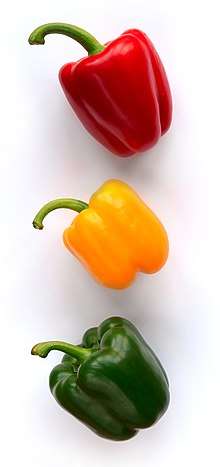 Red, yellow and green bell peppers | |
| Species | Capsicum annuum |
| Heat |
|
| Scoville scale | 0 SHU |
The bell pepper (also known as sweet pepper, pepper or capsicum /ˈkæpsɪkəm/) [1] is a cultivar group of the species Capsicum annuum.[2] Cultivars of the plant produce fruits in different colours, including red, yellow, orange, green, white, and purple. Bell peppers are sometimes grouped with less pungent pepper varieties as "sweet peppers".
Peppers are native to Mexico, Central America, and northern South America. Pepper seeds were imported to Spain in 1493, and from there, spread to Europe and Asia. The mild bell pepper cultivar was developed in 1920s, in Szeged, Hungary.[3]
Preferred growing conditions for bell peppers include warm, moist soil in a temperate range of 21 to 29 °C (70 to 84 °F).[4]
Nomenclature
The misleading name "pepper" was given by Europeans when Christopher Columbus brought the plant back to Europe. At that time, black pepper (peppercorns), from the unrelated plant Piper nigrum originating from India, was a highly prized condiment; the name "pepper" was at that time applied in Europe to all known spices with a hot and pungent taste and was therefore naturally extended to the newly discovered genus Capsicum. The most commonly used alternative name of the plant family, "chile", is of Mexican origin, from the Nahuatl word chilli. Botanically speaking, bell peppers are fruits; however, they are considered vegetables in culinary contexts.
The bell pepper is the only member of the genus Capsicum that does not produce capsaicin, a lipophilic chemical that can cause a strong burning sensation when it comes in contact with mucous membranes. The lack of capsaicin in bell peppers is due to a recessive form of a gene that eliminates capsaicin and, consequently, the "hot" taste usually associated with the rest of the genus Capsicum. This recessive gene is overwritten in the Mexibelle pepper, a hybrid variety of bell pepper that produces small amounts of capsaicin (and is thus mildly pungent). Sweet pepper cultivars produce non-pungent capsaicinoids.[5]
The terms "bell pepper" (US, Canada), "pepper" or "sweet pepper" (UK), and "capsicum" (Australia, India, New Zealand and Pakistan) are often used for any of the large bell-shaped peppers, regardless of their color. The vegetable is simply referred to as a "pepper", or additionally by color ("green pepper" or red, yellow, orange, purple, brown, black).[6] In the Midland region of the U.S., bell peppers when stuffed and pickled are sometimes called "mangoes."[7] Canadian English uses both "bell pepper" and "pepper" interchangeably.
In some languages, the term "paprika", which has its roots in the word for pepper, is used for both the spice and the fruit – sometimes referred to by their colour (e.g., "groene paprika", "gele paprika", in Dutch, which are green and yellow, respectively). The bell pepper is called "パプリカ" (papurika) or "ピーマン" (piiman, from Portuguese pimentão) in Japan.[8] In Switzerland, the fruit is mostly called "peperone", which is the Italian name of the fruit. In France, it is called "poivron", with the same root as "poivre" (meaning "pepper") or "piment". In Spain it is called "pimiento", which would be the masculine form of the traditional spice, "pimienta". In South Korea, the word "피망" (pimang from the Japanese "ピーマン" (piiman)) refers to green bell peppers, whereas "파프리카" (papeurika from paprika) refers to bell peppers of other colors. In Sri Lanka, the fruit used as a vegetable is called "maalu miris".
Colors

The most common colors of bell peppers are green, yellow, orange and red. More rarely, brown, white, lavender, and dark purple peppers can be seen, depending on the variety. Most typically, unripe fruits are green or, less commonly, pale yellow or purple. Red bell peppers are simply ripened green peppers,[9] although the Permagreen variety maintains its green color even when fully ripe. As such, mixed colored peppers also exist during parts of the ripening process. Green peppers are less sweet and slightly more bitter than yellow or orange peppers, with red bell peppers being the sweetest. The taste of ripe peppers can also vary with growing conditions and post-harvest storage treatment; the sweetest fruits are allowed to ripen fully on the plant in full sunshine, while fruit harvested green and after-ripened in storage is less sweet.
Nutritional value
| Nutritional value per 100 g (3.5 oz) | |
|---|---|
| Energy | 84 kJ (20 kcal) |
|
4.64 g | |
| Sugars | 2.4 g |
| Dietary fiber | 1.8 g |
|
0.17 g | |
|
0.86 g | |
| Vitamins | Quantity %DV† |
| Vitamin A equiv. |
2% 18 μg2% 208 μg341 μg |
| Thiamine (B1) |
5% 0.057 mg |
| Riboflavin (B2) |
2% 0.028 mg |
| Niacin (B3) |
3% 0.48 mg |
| Pantothenic acid (B5) |
2% 0.099 mg |
| Vitamin B6 |
17% 0.224 mg |
| Folate (B9) |
3% 10 μg |
| Vitamin C |
97% 80.4 mg |
| Vitamin E |
2% 0.37 mg |
| Vitamin K |
7% 7.4 μg |
| Minerals | Quantity %DV† |
| Calcium |
1% 10 mg |
| Iron |
3% 0.34 mg |
| Magnesium |
3% 10 mg |
| Manganese |
6% 0.122 mg |
| Phosphorus |
3% 20 mg |
| Potassium |
4% 175 mg |
| Sodium |
0% 3 mg |
| Zinc |
1% 0.13 mg |
| Other constituents | Quantity |
| Water | 93.9 g |
|
| |
| |
|
†Percentages are roughly approximated using US recommendations for adults. Source: USDA Nutrient Database | |
Bell peppers contain 94% water, 5% carbohydrates, and negligible fat and protein (table). They are rich sources of vitamin C, containing 97% of the Daily Value (DV) in a 100 gram reference amount (table). Red bell peppers have more vitamin C content than green bell peppers.[10] Vitamin B6 is moderate in content (17% DV), with no other micronutrients having significant amounts of the DV (table).
Production
China is the world's largest producer of bell and chile peppers, followed by Mexico, Turkey, Indonesia, and the United States.[11]
Gallery
 Orange bell pepper
Orange bell pepper- A variety of colored bell peppers
 Multicolored bell peppers
Multicolored bell peppers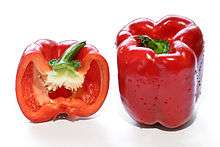 A whole and halved red bell pepper
A whole and halved red bell pepper A whole purple pepper
A whole purple pepper Red bell peppers
Red bell peppers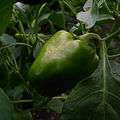 Japanese green pepper
Japanese green pepper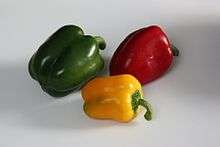 Green, yellow and red peppers
Green, yellow and red peppers_Flower.jpg) Quadrato d'Asti Giallo bell pepper flower
Quadrato d'Asti Giallo bell pepper flower Secondary fruit growing inside a capsicum annuum
Secondary fruit growing inside a capsicum annuum Red bell pepper as decoration
Red bell pepper as decoration- Yellow bell pepper plant
- Green bell pepper plant
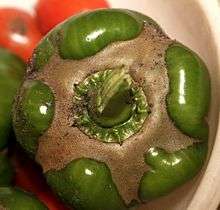 Bell Pepper with Cyclamen Mite damage
Bell Pepper with Cyclamen Mite damage.jpg) Chef chopping bell peppers
Chef chopping bell peppers
See also
| Wikimedia Commons has media related to Bell pepper. |
| Wikibooks Cookbook has a recipe/module on |
References
- ↑ Wells, John C. (2008), Longman Pronunciation Dictionary (3rd ed.), Longman, p. 123, ISBN 9781405881180
- ↑ "Capsicum annuum (bell pepper)". CABI. 28 November 2017. Retrieved 15 March 2018.
- ↑ Sasvari, Joanne (2005). Paprika: A Spicy Memoir from Hungary. Toronto, ON: CanWest Books. p. 202. ISBN 9781897229057. Retrieved 20 October 2016.
- ↑ "Growing Peppers: The Important Facts". GardenersGardening.com. Archived from the original on 27 January 2013. Retrieved 10 January 2013.
- ↑ Macho, Antonio; Lucena, Concepción; Sancho, Rocio; Daddario, Nives; Minassi, Alberto; Muñoz, Eduardo; Appendino, Giovanni (2003-02-01). "Non-pungent capsaicinoids from sweet pepper". European Journal of Nutrition. 42 (1): 2–9. doi:10.1007/s00394-003-0394-6. ISSN 1436-6207.
- ↑ "Bell and Chili Peppers". Agricultural Marketing Resource Center, US Department of Agriculture. October 2017. Retrieved 25 August 2018.
- ↑ "Dictionary of American Regional English". Retrieved 15 March 2018.
- ↑ Azhar Ali Farooqi; B. S. Sreeramu; K. N. Srinivasappa (2005). Cultivation of Spice Crops. Universities Press. pp. 336–. ISBN 978-81-7371-521-1. Retrieved 22 August 2010.
- ↑ "Vegetable of the Month: Bell Pepper". CDC Fruit & Vegetable of the Month. Archived from the original on 3 January 2003. Retrieved 9 April 2012.
- ↑ University of the District of Columbia. "Peppers" (PDF). Center for Nutrition, Diet and Health. Retrieved 13 March 2013.
- ↑ "Bell and chile peppers" (PDF). US Western Institute for Food Safety and Security. 2014. Retrieved 11 March 2018.